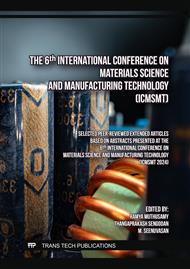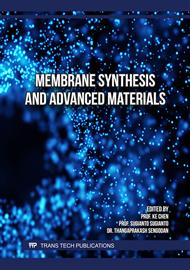[1]
R. Girimurugan, Pon.Maheskumar, G. Sahoo, A. Sivalingam, and S. Mayakannan, "Effect of nano alumina powder and water hyacinth stem powder addition on tensile properties of polypropylene matrix hybrid composites – An experimental study," Mater Today Proc, vol. 60, p.2099–2104, 2022.
DOI: 10.1016/j.matpr.2022.01.477
Google Scholar
[2]
K. Srividya et al., "Design and analysis of wear parameters for epoxy based composite using RSM-box behnken optimization tool," International Journal on Interactive Design and Manufacturing, 2023.
DOI: 10.1007/s12008-023-01449-8
Google Scholar
[3]
A. R. Lakshmipathi et al., "Shear strength, wear, thermal conductivity, and hydrophobicity behavior of fox millet husk biosilica and Amaranthus dubius stem fiber–reinforced epoxy composite: a concept of biomass conversion," Biomass Convers Biorefin, 2023.
DOI: 10.1007/s13399-023-04854-x
Google Scholar
[4]
S. Thangaraj, G. M. Pradeep, M. S. Heaven Dani, S. Mayakannan, and A. Benham, "Experimental investigations on tensile and compressive properties of nano alumina and arecanut shell powder reinforced polypropylene hybrid composites," Mater Today Proc, vol. 68, p.2243–2248, 2022.
DOI: 10.1016/j.matpr.2022.08.442
Google Scholar
[5]
R. Girimurugan, G. B. Loganathan, G. Sivaraman, C. Shilaja, and S. Mayakannan, "Compressive Behavior of Tamarind Shell Powder and Fine Granite Particles Reinforced Epoxy Matrix Based Hybrid Bio-Composites," 2022, p.7111–7118.
DOI: 10.1149/10701.7111ecst
Google Scholar
[6]
P. Thamizharasu et al., "Improvement of thermal performance of a solar box type cooker using SiO 2/TiO 2 Nanolayer," Silicon, p.1–9, 2020.
Google Scholar
[7]
K. Venkateswarlu and K. Ramakrishna, "Recent advances in phase change materials for thermal energy storage-a review," Journal of the Brazilian Society of Mechanical Sciences and Engineering, vol. 44, no. 1, p.6, 2022.
DOI: 10.1007/s40430-021-03308-7
Google Scholar
[8]
A. Raut, R. J. Singh, A. Murmu, and K. A. Khan, "Evaluation of thermal and energy consumption behavior of novel foamed copper slag based geopolymer masonry blocks," Ceram Int, vol. 48, no. 9, p.12098–12111, 2022.
DOI: 10.1016/j.ceramint.2022.01.070
Google Scholar
[9]
R. Girimurugan, C. Shilaja, S. Mayakannan, S. Rajesh, and B. Aravinth, "Experimental investigations on flexural and compressive properties of epoxy resin matrix sugarcane fiber and tamarind seed powder reinforced bio-composites," Mater Today Proc, vol. 66, p.822–828, 2022.
DOI: 10.1016/j.matpr.2022.04.386
Google Scholar
[10]
Y. Qian, S. Zhou, and X. Chen, "Synergistic flame retardant effect between nano-silicon dioxide and layered double hydroxides in ethylene vinyl acetate composites," Journal of Thermoplastic Composite Materials, vol. 31, no. 10, p.1295–1309, 2018.
DOI: 10.1177/0892705717738287
Google Scholar
[11]
X. J. Zhang et al., "Ternary flame retardant system of ammonium polyphosphate-diatomite-NANO-SiO2 and its application in fibrous materials," Dig J Nanomater Biostruct, vol. 15, no. 1, p.85–92, (2020)
Google Scholar
[12]
N.H. Huang, Z. J. Chen, C.H. Yi, and J. Q. Wang, "Synergistic flame retardant effects between sepiolite and magnesium hydroxide in ethylene-vinyl acetate (EVA) matrix," Express Polym Lett, vol. 4, no. 4, p.227–233, 2010.
DOI: 10.3144/expresspolymlett.2010.29
Google Scholar
[13]
C. Jiao, X. Zhao, W. Song, and X. Chen, "Synergistic flame retardant and smoke suppression effects of ferrous powder with ammonium polyphosphate in thermoplastic polyurethane composites," J Therm Anal Calorim, vol. 120, no. 2, p.1173–1181, 2015.
DOI: 10.1007/s10973-014-4377-z
Google Scholar
[14]
Y. Han et al., "Remarkable effects of silicone rubber on flame retardant property of high-density polyethylene/magnesium hydroxide composites," Polym Degrad Stab, vol. 203, 2022.
DOI: 10.1016/j.polymdegradstab.2022.110061
Google Scholar
[15]
C.I. Idumah, A. Hassan, and A.C. Affam, "A review of recent developments in flammability of polymer nanocomposites," Reviews in Chemical Engineering, vol.31, no. 2, p.149–177, 2015.
DOI: 10.1515/revce-2014-0038
Google Scholar
[16]
X. Chen, L. Liu, C. Jiao, Y. Qian, and S. Li, "Influence of ferrite yellow on combustion and smoke suppression properties in intumescent flame-retardant epoxy composites," High Perform Polym, vol. 27, no. 4, p.412–425, 2015.
DOI: 10.1177/0954008314553644
Google Scholar
[17]
L. Dong, Y. Su, C. Wang, Y. Qiao, Y. Chen, and H. Ma, "Synthesis of Micro- to Nano-scale Perovskite Calcium Hydroxytinate and Its Performance as a Flame Retardant in Epoxy Resin," Gaodeng Xuexiao Huaxue Xuebao/Chemical Journal of Chinese Universities, vol. 42, no. 3, p.937–945, 2021.
Google Scholar
[18]
W. Meng et al., "Assembling MXene with bio-phytic acid: Improving the fire safety and comprehensive properties of epoxy resin," Polym Test, vol. 110, 2022.
DOI: 10.1016/j.polymertesting.2022.107564
Google Scholar
[19]
Y. Liu, B. Xu, L. Qian, Y. Chen, and Y. Qiu, "Impact on flame retardancy and degradation behavior of intumescent flame-retardant EP composites by a hyperbranched triazine-based charring agent," Polym Adv Technol, vol. 31, no. 12, p.3316–3327, 2020.
DOI: 10.1002/pat.5055
Google Scholar
[20]
Y. Zou, W. Cui, D. Chen, F. Luo, and H. Li, "In Situ-Generated Heat-Resistant Hydrogen-Bonded Organic Framework for Remarkably Improving Both Flame Retardancy and Mechanical Properties of Epoxy Composites," ACS Appl Mater Interfaces, 2023.
DOI: 10.1021/acsami.3c09197
Google Scholar
[21]
X. Chen, L. Liu, and C. Jiao, "Influence of Iron Oxide Brown on Smoke-Suppression Properties and Combustion Behavior of Intumescent Flame-Retardant Epoxy Composites," Advances in Polymer Technology, vol. 34, no. 4, 2015.
DOI: 10.1002/adv.21516
Google Scholar
[22]
M.-J. Xu, S.-Y. Xia, C. Liu, and B. Li, "Preparation of Poly(phosphoric acid piperazine) and Its Application as an Effective Flame Retardant for Epoxy Resin," Chinese Journal of Polymer Science (English Edition), vol. 36, no. 5, p.655–664, 2018.
DOI: 10.1007/s10118-018-2036-8
Google Scholar
[23]
L. Liu, X. Chen, and C. Jiao, "Influence of ferrocene on smoke suppression properties and combustion behavior of intumescent flame-retardant epoxy composites," J Therm Anal Calorim, vol. 122, no. 1, p.437–447, 2015.
DOI: 10.1007/s10973-015-4928-y
Google Scholar
[24]
M. Ou et al., "Co-curing preparation of flame retardant and smoke-suppressive epoxy resin with a novel phosphorus-containing ionic liquid," Chemosphere, vol. 311, 2023.
DOI: 10.1016/j.chemosphere.2022.137061
Google Scholar
[25]
A. Sethurajaperumal, A. Manohar, A. Banerjee, E. Varrla, H. Wang, and K. Ostrikov, "A thermally insulating vermiculite nanosheet-epoxy nanocomposite paint as a fire-resistant wood coating," Nanoscale Adv, vol. 3, no. 14, p.4235–4243, 2021.
DOI: 10.1039/d1na00207d
Google Scholar
[26]
L. Ali et al., "Removal of Bromine from the non-metallic fraction in printed circuit board via its Co-pyrolysis with alumina," Waste Management, vol. 137, p.283–293, 2022.
DOI: 10.1016/j.wasman.2021.11.025
Google Scholar



